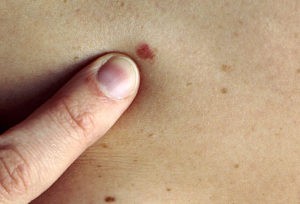- You are here:
- Home »
- Blog »
- Non-Melanoma Skin Cancer »
- Melanoma Dx- Evidence-based, Non-toxic Skin Cancer Therapies
Melanoma Dx- Evidence-based, Non-toxic Skin Cancer Therapies
Chronic exposure of solar UV radiation to the skin leads to basal cell and squamous cell carcinoma, and melanoma.
Cancer Coach- Hi from the UK. I am a 3 year stage 3B melanoma survivor who is under a “watch and wait” program after removal of the melanoma.
I have modified my diet to fully plant bases, added enzymes and a good supplement program including monitoring blood levels of vitamin D3. Feels like I should be doing more.Any suggestions or your programs welcome. I did have lymph node removal but had no primary. Thank you. Ian
Hi Ian-When you say that you are “under a watch and wait program” I take you to mean that you had therapy for melanoma when you were diagnosed and once that was finished your oncologist told you to watch and wait? I understand that this is the standard approach of conventional oncology.
If my thinking is correct above and you are wondering about other therapies that you should be doing to reduce your risk of relapse?
First of all, what you have been doing on your own 1) eating more fruits and veggies 2) supplementing with enzymes, other supplements are good first steps. You may already be supplementing with specifics below, I am simply itemizing specific supplements.
The three studies linked and excerpted below offer non-toxic therapies for you to consider. Further, the skin cancer guide linked in the upper right corner of the page offers evidence-based, non-toxic skin cancer therapies that offer the added benefit of increasing your skin health. Consider younger looking skin!
Scroll down the page to ask me a question or leave a comment. I will reply to you ASAP.
Thanks
David Emerson
- Cancer Survivor
- Cancer Coach
- Director PeopleBeatingCancer
Recommended Reading:
- Basal Cell Carcinoma Treatment
- Skin Cancer As You Age- Before, During and After Diagnosis
- The “BEST” Treatments for Basel Cell Carcinoma?
Phytochemicals for the Management of Melanoma.
“Melanoma claims approximately 80% of skin cancer-related deaths. Its life-threatening nature is primarily due to a propensity to metastasize. The prognosis for melanoma patients with distal metastasis is bleak, with median survival of six months even with the latest available treatments.
Phytochemicals are gaining considerable attention because of their low toxicity, low cost, and public acceptance as dietary supplements. Cell culture and animals studies have elucidated several cellular and molecular mechanisms by which phytochemicals act in the prevention and treatment of metastatic melanoma.
Several promising phytochemicals, such as, fisetin, epigallocatechin-3-gallate, resveratrol, curcumin, proanthocyanidins, silymarin, apigenin, capsaicin, genistein, indole-3-carbinol, and luteolin are gaining considerable attention and found in a variety of fresh fruits, vegetables, roots, and herbs.
In this review, we will discuss the preventive potential, therapeutic effects, bioavailability and structure activity relationship of these selected phytochemicals for the management of melanoma.”
Silymarin and skin cancer prevention: anti-inflammatory, antioxidant and immunomodulatory effects (Review).
“Several environmental and genetic factors are involved in skin cancer induction, however exposure to chemical carcinogens and solar ultraviolet (UV) radiation are primarily responsible for several skin diseases including skin cancer.
Chronic exposure of solar UV radiation to the skin leads to basal cell and squamous cell carcinoma, and melanoma. Chemoprevention of skin cancer by consumption of naturally occurring botanicals appears a practical approach and therefore world-wide interest is considerably increasing to use these botanicals.
Silymarin, a plant flavonoid isolated from the seeds of milk thistle (Silybum marianum), has been shown to have chemopreventive effects against chemical carcinogenesis as well as photocarcinogenesis in various animal tumor models.
Wide range of in vivo mechanistic studies indicated that silymarin possesses antioxidant, anti-inflammatory and immunomodulatory properties which may lead to the prevention of skin cancer in in vivo animal models.
The available experimental information suggests that silymarin is a promising chemopreventive and pharmacologically safe agent which can be exploited or tested against skin cancer in human system. Moreover, silymarin may favorably supplement sunscreen protection and provide additional anti-photocarcinogenic protection.”
The curcumin analog DM-1 induces apoptotic cell death in melanoma.
“The main difficulty in the successful treatment of metastatic melanoma is that this type of cancer is known to be resistant to chemotherapy. Chemotherapy remains the treatment of choice, and dacarbazine (DTIC) is the best standard treatment.
The DM-1 compound is a curcumin analog that possesses several curcumin characteristics, such as antiproliferative, antitumor, and antimetastatic properties. The objective of this study was to evaluate the signaling pathways involved in melanoma cell death after treatment with DM-1 compared to the standard agent for melanoma treatment, DTIC.
DM-1 induced significant apoptosis as indicated by the presence of cleaved caspase 8 and an increase in TNF-R1 expression in melanoma cells. Furthermore, DM-1 had antiproliferative effects in this the same cell line. DTIC caused cell death primarily by necrosis, and a smaller melanoma cell population underwent apoptosis. DTIC induced oxidative stress and several physiological changes in normal melanocytes, whereas DM-1 did not significantly affect the normal cells.
DM-1 antitumor therapy in vivo showed tumor burden decrease with DM-1 monotherapy or in combination with DTIC, besides survival rate increase. Altogether, these data confirm DM-1 as a chemotherapeutic agent with effective tumor control properties and a lower incidence of side effects in normal cells compared to DTIC.”


